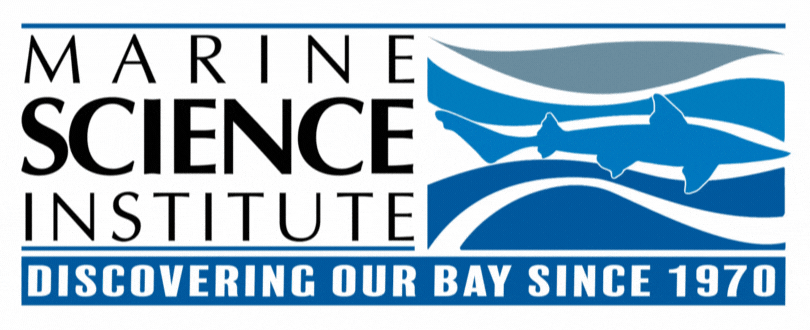Sharktober CREATURE FEATURE: leopard shark
- Naomi Deal
- Sep 27, 2022
- 2 min read
Bring on the chondrichthyes!

Marine Science Institute's mascot and the most common shark found in the San Francisco Bay area is the leopard shark (Triakis semifasciata). At typical maximum length, males reach up to 5 feet and females up to 6 feet, but these docile sharks have been recorded up to 7 feet in length. Leopard sharks are ovoviviparous---the process in which embryos develop inside eggs that hatch internally, thus, giving birth to live young. Shark pups feed on the egg's yolk sack during gestation, a period that lasts for 10-12 months. One litter could contain as few as 4 or as many as 30 pups!
Leopard sharks feed on crabs, worms, clams and other marine invertebrates until they reach a larger size. Once they grow they can then feed on a variety of fish. These shark's mouths are located under their heads which makes it easy to feed on benthic (bottom) dwellers. Shark teeth are unique and each species of sharks have rows of teeth so when they lose one or more the others will rotate forward. The arrangement of teeth in different sharks depends on what and where they are feeding. Leopard shark teeth are flat and over-lapping allowing easier feeding on clams and crabs.
Leopard shark's meat is consumed by humans and taken by both commercial and recreational fishers and are not considered to be a threatened species. According to the Current California Ocean Recreational Fishing Regulations, inside the San Francisco Bay, leopard shark fishing is open year-round to boat-based anglers, divers and shore-based anglers with bag and possession limit of 3 sharks with a minimum size limit of 36 inches in length. However, due to high levels of mercury contamination in the SF Bay, The Office of Environmental Health Hazard Assessment (OEHHA) does not recommend eating leopard sharks caught in the bay for women of child-bearing age and children. Check out the OEHHA Guide To Eating Fish From San Francisco Bay to learn more about what fish are healthy for us to eat, and the appropriate serving sizes.

Updated by Tiffany Murzi
Resources and References:
Leopard shark. Animal Guide. Animals & Exhibits at the Monterey Bay Aquarium. (September 2022) http://www.montereybayaquarium.org/animal-guide/fishes/leopard-shark
Arkive Wildscreen. Leopard shark. (September 2022) http://www.arkive.org/leopard-shark/triakis-semifasciata/
Current California Ocean Recreational Fishing Regulations. Marine Region (Region 7) (September, 2022). https://www.wildlife.ca.gov/Fishing/Ocean/Regulations/Fishing-Map/sf-bay#leopard






Ücretsiz Rastgele Görüntülü Sohbet Kameralı Sohbet Gabile Sohbet Canlı Sohbet Cinsel Sohbet Yetişkin Sohbet Sorunsuz Yeni Kişilerle Tanışma İmkanı Sağlar.
https://www.gevezeyeri.com/
https://askyeriniz.blogspot.com/
https://soh--bet.blogspot.com/
https://yetiskinchatt.blogspot.com/
https://livechattt.blogspot.com/
Gabile Sohbet Cinsel Sohbet Yetişkin Sohbet
https://forum.profa.ne/user/yetiskinsohbet
http://jobs.emiogp.com/author/yetiskinsohbet/
https://justpaste.it/45ocq
https://www.grepmed.com/chat1
https://divisionmidway.org/jobs/author/yetiskinsohbet/
https://www.guiafacillagos.com.br/author/yetiskinsohbet/
https://utahsyardsale.com/author/yetiskinsohbet/
https://allmynursejobs.com/author/yetiskinsohbet/
http://jobboard.piasd.org/author/yetiskinsohbet/
http://www.annunciogratis.net/author/yetiskinsohbet
https://employbahamians.com/author/yetiskinsohbet/
https://rnmanagers.com/author/yetiskinsohbet/
https://rnstaffers.com/author/yetiskinsohbet/
https://www.i-hire.ca/author/yetiskinsohbet/
https://veterinarypracticetransition.com/author/yetiskinsohbet/
https://www.lotusforsale.com/author/yetiskinsohbet/
https://aboutnurseassistantjobs.com/author/yetiskinsohbet/
https://www.montessorijobsuk.co.uk/author/yetiskinsohbet/
https://www.sitiosecuador.com/author/yetiskinchat/
https://aboutsnfjobs.com/author/yetiskinchat/
https://www.ocjobs.com/employers/3420821-yetiskinsohbet
https://jobs.theeducatorsroom.com/author/yetiskinsohbet/
https://cuchichi.es/author/yetiskinsohbet/
https://www.ziparticle.com/author/yetiskinchat/
https://praca.uxlabs.pl/author/yetiskinchat/
https://rnopportunities.com/author/gabilechat/
https://rnstaffers.com/author/yetiskinchat/
https://www.montessorijobsuk.co.uk/author/gabilechat/
https://www.allmyusjobs.com/author/gabilechat/
https://www.nursingportal.ca/author/cinselsohbett/
https://www.fmconsulting.net/gymsforsale/author/gabilechat/
https://www.animaljobsdirect.com/employers/3424370-yetiskinsohbet